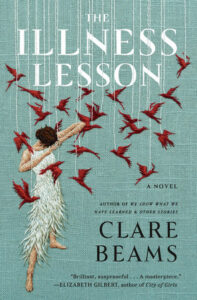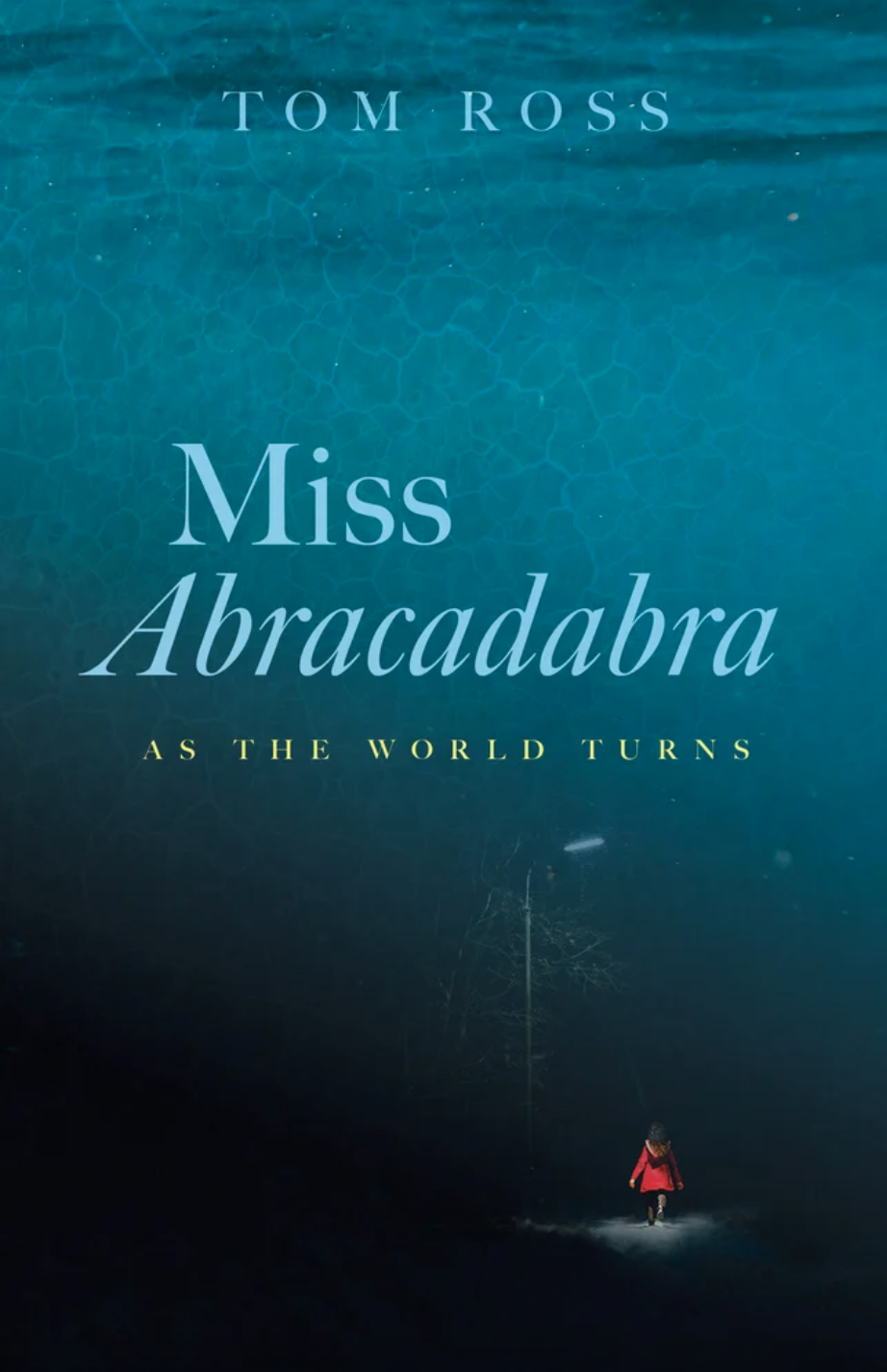Book by CLARE BEAMS
Review by ETHAN CHATAGNIER
The events of Clare Beams’ debut novel, The Illness Lesson, start with the founding of a school for girls in 19th-century New England, but the novel begins just before that with an omen. A flock of mysterious red birds visits the Massachusetts estate of Samuel Hood for the first time since the collapse of his previous social experiment decades earlier, a failed agricultural commune called the Birch Hill Consociation. Some find the birds beautiful, but to Samuel’s daughter, Caroline, their “shape might be a red so bright and so unexpected, so unlike the colors of her life, that it held a violence.” Samuel is a noted idealist in the tradition of Ralph Waldo Emerson, and he, Caroline, and his acolyte David live off the income of his Transcendentalist essays. The girls’ school is an attempt to prove his latest hypothesis: that girls can be ushered into the world of ideas as easily as boys.
The Illness Lesson is a novel that hovers pleasantly between modes. It is a historical novel that doesn’t latch onto specifics. Its events occur sometime in the wake of the Civil War, but you won’t hear the names of battles or presidents. There’s not a lot of filigreed period dress here so much as the spare set decoration of a play. Against that backdrop, the story plays out with the aura of a fable. You could imagine the spirits of Nathaniel Hawthorne’s early American tales wandering around these woods, though the book is not a supernatural one and its dangers are not ghosts. Beams’ previous book, the short story collection We Show What We Have Learned, is a mix of historical realist character studies and magical realist tales, and in this novel she has blended the two. Her cast of characters here are Enlightenment rationalists, but their world is vulnerable to superstition.
The novel comes to us through the perspective of Caroline, Samuel’s prototype for the education of girls, and it begins with Samuel proposing the school and planning its inception with Caroline and David. Caroline is a devoted daughter, but her education, although conducted under her father’s personal tutelage, has led her away from his rosy optimism. When Samuel crows that they’ll teach “thinking, not sewing or physical graces, not shallow parlor-trick erudition,” Caroline responds: “Of course there’s the matter of what they’re to do with all that after.” Samuel is undaunted by Caroline’s hesitancy. He sees himself as a magician of ideas, and like a magician he takes inspiration from a doubting audience.
Some part of Caroline’s immunity to Samuel’s lofty notions comes from having grown up among the ruins of one of them twenty years earlier. The Birch Hill Consociation fell apart as a result of being filled with men who Caroline thinks had “a greater affinity for ideas than for planks” or plows. Caroline knows that dreams can have a cost, as her mother’s life was carried away by a mysterious illness in the aftermath of the experiment. But Caroline also understands that learning to see, for girls, often means only better seeing the bars of their metaphorical cages. In her own family, her education has granted her the freedom to comment, even to critique, but it has not granted any of her reservations the weight of a vote. As Beams writes: “Though Caroline was meant to be a walking embodiment of the school’s aims, that didn’t mean her feminine fingers belonged in its meatier pies.”
Of the girls school’s three starting faculty—Samuel, Caroline, and David—Caroline is the only one who understands that girls can be sharp in more ways than one. She keeps most of her doubts close, and when she does voice them it becomes apparent why: Samuel treats her reservations as minor dissents that don’t merit a strong rebuttal—objection noted; objection dismissed. As she suspects, their eight students prove a more complicated territory than Samuel or David foresaw, particularly Eliza Pearson Bell. Eliza quickly becomes a lodestar to the rest of the girls, exerting a gravity upon them that challenges the instructors. She also wields a complicated history: she is the daughter of one of the Birch Hill men, Miles Pearson, who wrote a sensationalist novel about the commune, including an affair between his hero and a character based on Caroline’s mother. It’s painfully obvious that Samuel does not want Eliza there, but his commitment to the project’s ideals keeps him from rejecting her admission to the school.
Eliza, who leads the other girls in class discussion and passing fashions, leads them in sickness as well. She is the first to have a fainting spell, a burst blood vessel in her eye. The rest follow with rashes, weakness, speech tics, and a scattering of other symptoms. Even Caroline sees Eliza as the greatest threat to the project when Eliza ferries the rest of the girls into illness. Soon the girls are mostly bed bound with mysterious, unpredictable ailments, their status changed from students to patients. Is the source of their ailments in their bodies? Their souls? Their ideas? The book devotes some time to Samuel, David, and Caroline’s exploration of potential causes, but it’s not a medical mystery and it’s not concerned with providing a diagnosis. Its interest is the way the girls’ humanity becomes secondary when their illness threatens to derail Samuel’s project.
Once the girls are objects to fix, their agency (which they are ostensibly at the school to develop) doesn’t matter so much as the men’s theories about how to correct them. The novel gives us antagonistic men: Thoreson, the head of a more rigid, rival school teaching girls home economics through disciplinarian methods, aiming to instruct the young women’s temperament rather than their souls. He visits hoping to see Samuel’s methods failing, and leaves surprised by the girls’ intellectual acuity. He and Hawkins, an arrogant Birch Hill physician who will return to treat the girls later, are set up as foils to gentle, egalitarian Samuel. But the novel is more focused on David and Samuel, whose intentions, at least, Caroline has come to trust. Yet even those men’s intentions are set to the test when they are forced to choose how they’ll use their power to define the reality of the girls in their care. The lesson of the book’s title, which Caroline learns haltingly, comes from the alarming steps Samuel and David end up willing to take in their attempts to cure the girls. We come to see that idealists interested in women’s equality often value their thesis statements more than they value women themselves.
Beams is an elegant stylist, from her descriptive powers—a bird’s black eye “had the sightless sheen of a drop of oil”—to the concise, cutting assessments Caroline makes of those around her—“She couldn’t believe [Hawkins’] thick fingers would be able to feel the pulse of what ailed these girls. His eyes were so full of what he expected to see that he wouldn’t really look at them.” This grace extends to the novel’s plotting and prose as well. Though the novel’s era and setting recall authors like Hawthorne and Henry James, it doesn’t feel like a product of this time period. You won’t find labyrinthine sentences and lengthy paragraphs, and the plot progressions are carefully meted out. The author seems wary of excess, of digression, and manages the steady accumulation of pressure on her characters with a firm hand akin to a screenwriter’s. The book has the feel of a sleek modern novel in the costume dress of an earlier time, which gives it an allegorical atmosphere. By avoiding heavy attachment to period detail, Beams makes clear that the problems she’s investigating are not confined to a single time or place.
The Illness Lesson’s final stretch shifts toward a different genre—horror—but a variety that requires no mythical monsters, and is all the more unsettling for its plausibility. The tragedy that befalls the school is one that resonates uneasily with modern events. In this last section, the book achieves its most haunting power: when the women of the Trilling Heart School must decide what to say, and the men of the school must decide what to hear. This reckoning leads the reader to understand this novel’s power as a realist fable and a historical novel about the horrors of today.
Ethan Chatagnier is a fiction writer with work in the New England Review, the Georgia Review, Five Points, and other journals. His critical writing and interviews have appeared or are forthcoming in the Kenyon Review Online, The Millions, CRAFT, and TriQuarterly. He lives in Fresno, California with his family.





